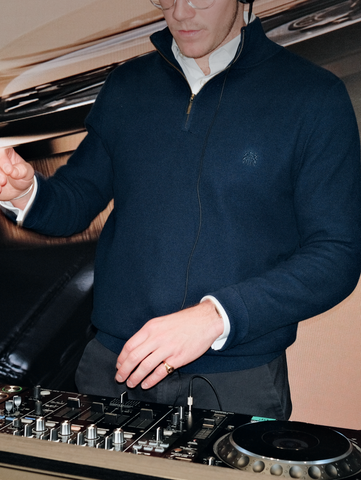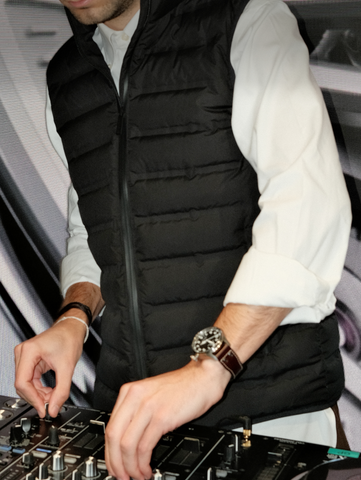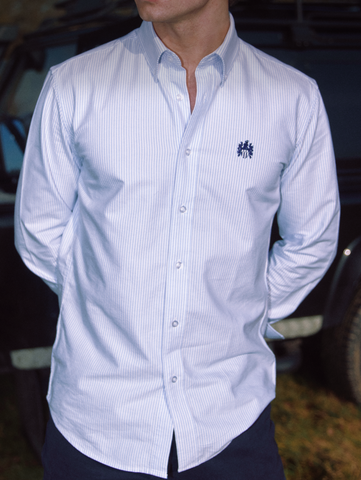Can a Quarter Zip Sweater Be Business Casual?
Can a Quarter Zip Sweater Be Business Casual?
The phrase business casual is the corporate world’s biggest inside joke. It’s the dress code that means everything and nothing at the same time. Suits without ties. Chinos pretending to be trousers. But somewhere in the middle of all this ambiguity sits the Quarter Zip sweater.
Once reserved for golf courses and weekends, it’s now slipped quietly into boardrooms, trading floors, and after-work drinks.
The question is no longer can a Quarter Zip be business casual? It’s why wouldn’t it be?
In this guide, we’ll break down how the Quarter Zip earned its place in modern office culture, when it works, and the styling rules that separate sharp from sloppy.
Is a Quarter Zip Professional Enough for the Office?
That depends entirely on the fabric. A lightweight Merino wool quarter zip reads as modern tailoring. A polyester fleece from the high street reads as cost-cutting with a zip. One signals intent. The other signals you’ve given up.
A properly constructed Quarter Zip constructed from lightweight ultra-fine Merino Wool, subtle ribbing, and minimal branding reads as contemporary business attire. Think Mayfair private members’ club rather than student union bar. It suggests you understand that formality has evolved, but you haven't mistaken evolution for abdication.
On the other hand, anything plastered with a tech startup logo, rendered in performance fabrics, or purchased in bulk for "team building" belongs nowhere near a professional setting. The Quarter Zip is not activewear. It's tailored knitwear with a considered detail.
What Industries Actually Accept Quarter Zips As Business Casual?
Finance: The New Tie
In finance, the Quarter Zip is the new tie. Private equity, venture capital, boutique advisory, investment banking. Anywhere standards remain high but formality has relaxed, it’s become the uniform. A fine Merino Quarter Zip with tailored wool trousers and loafers projects authority without theatre. It’s what separates a man who manages assets from a boy who manages spreadsheets.
Tech: From Hoodie to Executive Presence
The Quarter Zip is practically ceremonial attire in tech. However, the bar is so catastrophically low (hoodies, joggers, those inexplicable horrific squeaky trainers) that simply wearing a Merino Wool Quarter Zip instead will elevate you from start-up casual to executive presence.
Law: Casual Fridays Only
Magic Circle firms remain resistant. But media law, IP boutiques, and anything involving startups have quietly accepted the Quarter Zip as Friday office attire. Notably absent: anything resembling colour.
Creative Industries: Effort Disguised As Ease
In Advertising, PR, and brand consultancy, the Quarter Zip works here because the industry rewards effort disguised as ease. The trick is looking like you've dressed down from something more formal, not up from the gym.
Consulting: Authority Without Stiffness
Consulting firms fully accept the Quarter Zip as business casual. It strikes the right balance: smart enough to face a client, flexible enough for airport lounges and late-night project rooms. A refined Quarter Zip signals you’re at the level setting strategy, and not the one formatting the slides.
How to Style a Quarter Zip for Work: The Fabric Hierarchy
Merino Wool
Temperature-regulating, naturally wrinkle-resistant, odour-resistant, and possessing that matte finish that photographs well for a LinkedIn profile picture. This is the fabric that moves a Quarter Zip from weekend staple to boardroom appropriate, making it the standard for anyone who takes business casual seriously.
Cashmere
Acceptable if you're senior enough that nobody questions your choices. Slightly precious otherwise. Save it for when you’re at the Snow Polo in St. Moritz.
Cotton
Cotton Quarter Zips are the entry point into the category. They’re versatile, breathable, and easy to wear. They sit firmly in business casual territory, especially when cut cleanly and styled simply. Our Mesh Knit Quarter Zip brings a lighter, textured option for warmer months, while the Standard SIGNET Cotton Quarter Zip delivers a reliable everyday staple. Both show how cotton, when constructed well, moves far beyond weekend wear into professional settings.
Polyester/Performance Fabrics
Polyester is the death of business casual. It shines under office lights, clings in the wrong places, and makes a Quarter Zip look less like clothing and more like a promotional freebie. Performance blends promise breathability and stretch but deliver the aesthetic of a corporate golf day. Wear it to the gym or on a budget airline. In a professional setting, polyester says you’ve given up, on standards, on style, and on being taken seriously by anybody.
Fit: The Non-Negotiables
The Quarter Zip should skim your frame, not engulf it. Shoulder seams must hit at the shoulder, not drift towards your biceps like a borrowed jumper. Sleeves should end at your wrist bone any longer and you resemble a child in hand-me-downs.
Baggy is unforgivable. This isn't American athleisure; it's European tailoring with a zipper. The silhouette should suggest you own the garment, not that it owns you.
How to Choose Your Quarter Zip Colour: A Brief Hierarchy
Navy Blue: universal and utterly safe. The diplomatic passport of business casual.
Charcoal Grey: sophisticated without trying. Pairs with everything, offends nobody.
Heather Grey: borderline. Acceptable in creative industries, questionable in finance.
Camel/Beige: old-money signaling. Requires confidence and well-made shoes.
Racing Green: contemporary, but risky. Works in tech and media. Avoid in law and traditional finance.
Black: A black Quarter Zip is the default power move. It works everywhere and leaves nothing to hide behind.
Orange: Indefensible. If you want attention that badly, start running marathons like a normal person.
The Underlayer: Why A Collar Is Non-Negotiable
A Quarter Zip worn over a T-shirt is not business casual. It's weekend casual at best, airport attire at worst.
The proper foundation is a collared shirt, Oxford cloth button-down, dress shirt, or similar. The collar should be visible above the neckline. This single detail transforms the look from "I've just come from the gym" to "I've simply removed my blazer."
White and light blue are safest. Pink signals confidence (or finance).
Trousers: The Bottom Half That Makes or Breaks the Look
Tailored chinos, wool trousers, or shirt trousers. The Quarter Zip is doing enough casual lifting; your lower half must compensate with structure.
Jeans are acceptable only if your office explicitly permits denim and you've chosen dark, slim-cut styles without distressing. Even then, you're courting the edge of acceptability.
Never tracksuit trousers. Never chinos with elastic cuffs. Never anything you could conceivably sleep in.
Footwear: The Final Referendum
Leather loafers, brogues, Chelsea boots.
Brown leather in creative fields. Black in conservative industries. Suede if you're certain of your standing.
Anything overtly athletic negates the entire outfit. You've dressed up the top and abandoned the bottom. Consistency, as with all things sartorial, is credibility.
Quarter Zip Mistakes That Instantly Undermine Professionalism
Massive Branding
Huge logos and screen print text are for tourists and regional sales managers. A Quarter Zip should signal taste, not affiliation with a lifestyle brand you discovered on sale at Bicester Village.
Oversized Fits
This isn't streetwear. Tailoring implies competence. Bagginess implies you've borrowed your father's knitwear.
Athletic Fabrics
Moisture-wicking technology belongs in a spin class, not a strategy meeting. Merino breathes. Polyester screams. And that scream is ‘help’.
Pairing with Casual Underlayers
T-shirts, henleys, or heaven forbid hoodies underneath. The Quarter Zip must sit on top of something with a collar in a professional setting, or it reads as weekend wear.
Ignoring Colour Theory
Navy Quarter Zip, navy trousers, navy shoes: monotony. Navy Quarter Zip, grey trousers, brown shoes: sophistication. The devil, as they say, is in the tonal variation.
Why Premium Quarter Zips Look Better In The Office
Not all Quarter Zips are created equal, which becomes painfully obvious in office lighting.
The difference between a £40 polyester number and a proper Merino Wool piece is the difference between looking assembled and looking considered. SIGNET's approach to the Quarter Zip understands this implicitly: lightweight merino construction, European-leaning fit that skims without clinging, and finishing details that photograph well in video calls while looking equally sharp in person.
It's the sort of piece that suggests you've put thought into your appearance without labouring it which is rather the entire point of business casual.
When Quarter Zips Isn't The Right Choice
Client-Facing Presentations in Traditional Industries
Banking, law, consulting if you're pitching, default to tailoring. The Quarter Zip is for internal credibility, not external persuasion.
Formal Business Environments
Any office where "business casual" still means blazers. Read the room. The Quarter Zip is modern business casual, not universal business casual.
When You're the Youngest in the Meeting
Seniority affords latitude. Junior staff should err conservative. Once you've earned credibility, you can afford to dress down slightly. The intern in a Quarter Zip looks confused. The managing director in a Quarter Zip looks decisive.
The Verdict: The Quarter Zip Is Business Casual. If You Treat It Like It.
The Quarter Zip is not up for debate. It belongs in business casual, but only when treated with the seriousness of tailored knitwear, not the delusion of weekend athleisure.
Merino Wool and Cotton over polyester. Structure over slouch. Muted over loud.
Colour should work with your wardrobe, not fight it. Branding is acceptable when it feels deliberate. A mark of craft, not a billboard.
Worn well, the Quarter Zip signals modern professionalism: confident, understated, and precise.
Worn badly, it looks like weekend leisurewear that strolled into a client meeting.
The Quarter Zip isn’t trying to prove itself anymore. The only question is whether yours proves you.








